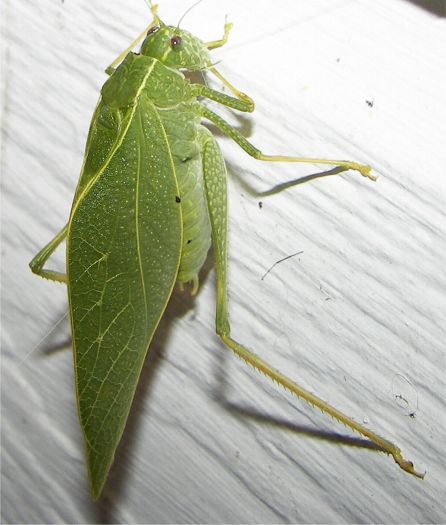 |
Return to Texas Entomology - Compiled by Mike Quinn
 |
Line
drawing of
male, by Martha B Lackey.
Fig. 25 from Alexander,
Pace, and Otte 1972.
Distribution
data per Singing Insects of North America
November 2003
Range: Eastern and southwestern U.S.
Males have two songs, the most distinctive is a rhythmic, even tic, tic, tic, tic, song that goes on for approximately 20 clicks.
Habitat: Arboreal, found on many kinds of trees (Helfer, 1962)
Season: Primarily two generations per year, June to August and October to November in northern Florida. Graph
Abundance: May be very common in rural backyards (Elliott & Hershberger, 2007)
Damage: Although rare, leaf damage, particularly to young trees, can be extremely severe. (Griffiths, 1952)
Similar Species: There are six species of Microcentrum in the U.S., five occur in (or very near) Texas:
Microcentrum latifrons - Southwestern angle-wing
Microcentrum louisianum - Louisiana angle-wing
Microcentrum minus - Texas angle-wing
Microcentrum retinerve - Lesser angle-wing
Microcentrum rhombifolium - Greater angle-wing
Etymology: Microcentrum rhombifolium (Saussure 1859)
micr, -o (G). Small
centr, -i, -o, =um (G). The center; a point, spur
rhomb, -o, =us (G). A parallelopiped with equal sides; a top
foli, -a, =um (L). A leaf
Biography: Henri Louis Frederic de Saussure (1829-1905), Swiss mineralogist and entomologist - Wikipedia
Bibliography:
Alexander, R.D, Pace, A.E, & Otte, D. 1972. The singing insects of Michigan. Great Lakes Entomologist, 5: 33-69.
Blatchley, W.S. 1920. Orthoptera of northeastern America. Nature Publishing Co., Indianapolis. 784 pp.
Bland, R. 2003. Orthoptera of Michigan. Michigan State University Extension, East Lansing. 220 pp.
Borror, D.J. 1960. Dictionary of Word Roots and Combining Forms. National Press Books, Palo Alto. 134 pp.
Capinera, J.L. & R.D. Scott, T.J. Walker. 2005. Field Guide to Grasshoppers, Katydids, and Crickets of the United States. Cornell University Press, Ithaca, New York. 280 pp.
Elliott, L. & W. Hershberger. 2007. The Songs of Insects. Houghton Mifflin, Boston. 228 pp.; sonagrams, color photographs.
Griffiths, J.T. 1952. Some biological notes on katydids in Florida citrus groves. Florida Entomologist, 35: 134-138.
Helfer, J.R. 1962. How to Know the Grasshoppers, Cockroaches, and Their Allies. Wm. C. Brown Company, Dubuque. 353 pp.
Taber, S.W. & S.B. Fleenor. 2003. Insects of the Texas Lost Pines. Texas A&M University, College Station. 283 pp.
19 Nov 2008 © Mike Quinn / entomike@gmail.com / Texas Entomology / Katydids of Texas